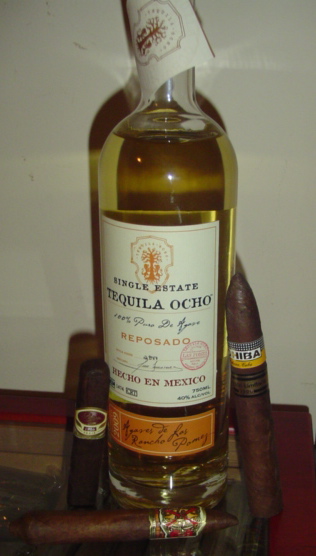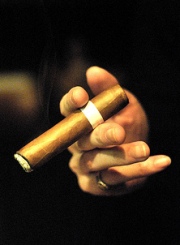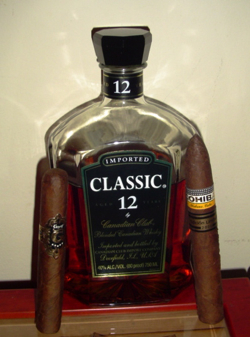Stogie Spirits: Tequila Ocho Reposado 2009
28 Apr 2009
When people think tequila, many think of margaritas or a burning shot sandwiched between a lick of salt and a wedge of lime. Tequila Ocho is out to break tequila’s frat boy reputation and remind you that tequila can be as refined as a top scotch, bourbon, or cognac. Towards that end, it succeeds in impressive fashion.
 Tequila Ocho is the first single estate vintage tequila to be introduced in the U.S. That means all the agave plants used—100% blue agave—are grown on a single plot of land and, like vintage bourbon, from a single harvest (in this case 2008).
Tequila Ocho is the first single estate vintage tequila to be introduced in the U.S. That means all the agave plants used—100% blue agave—are grown on a single plot of land and, like vintage bourbon, from a single harvest (in this case 2008).
Unlike grapes where the same plot of land will bear ripe fruit every year, agave takes ten years before it is mature enough for harvest. This means that the plots of land used for the 2009 release will not be ready to produce agave ready to be distilled again until 2018, adding to the rare nature of each vintage.
Tequila Ocho comes in three variations, Plata and Reposado, which can be found in select cities in the U.S., and an Anejo which, due to the extra aging that is required, won’t be available until the summer.
The Reposado, the subject of this article, and the Plata are both made from agave from Las Pomez, an estate located in the “Los Altos†highlands. According to Tequila Ocho, this high elevation produces “extremely high sugar content in the agave plant.”
Whether it’s that high sugar content or something else, the Reposado has a wonderful nose. Not at all harsh on your nostrils, it is best described as delicate with a lemon custard aroma and a hint of pine.
But it really shined when the Ocho Reposado, which I tasted neat, finally touched my tastebuds. It greeted me with a smooth burst of citrus, mint, and oak. The finish was long and gentle. In case you’re wondering, sucking on a wedge of lime after sipping this smooth, subtle tequila would be wholly inappropriate.
Tomas Estes, one of two people to be named an official “Tequila Ambassador” by the Mexican government and a driving force behind Tequila Ocho, says he likes to pair Tequila Ocho with milder Mexican smokes. I’d certainly agree that a milder smoke is best, so as not to overwhelm the Reposado’s subtle flavors. Three cigars that come to mind are the Ashton Classic, Fuente Privada, or Ybor City Handmade. (That mild profile is the exact opposite of the cigars photographed with the Tequila Ocho: an Opus X Chili Pepper, a Cohiba Pirámides Edición Limitada 2006, and a Padrón Serie 1926.)
At $70 per bottle, the Tequila Ocho Reposado 2009 is not cheap. But the money would be well spent on a superb tequila that will expand your notion of what tequila can be.
photo credit: Stogie Guys

 Located in a shop on the Near North Side of the Windy City, Tesa cigars are “meticulously blended by Chicago area resident Chris Kelly and crafted in the Tesa Cigar factory in
Located in a shop on the Near North Side of the Windy City, Tesa cigars are “meticulously blended by Chicago area resident Chris Kelly and crafted in the Tesa Cigar factory in 


 1) Criminalizing the act of smoking inside tobacco shops is ridiculous at best and tyrannical at worst. But that’s exactly what some
1) Criminalizing the act of smoking inside tobacco shops is ridiculous at best and tyrannical at worst. But that’s exactly what some  Before the Petit Edmundo hit the market, though, there was the Edmundo vitola. It, like its shorter and younger offspring, was named for Edmond Dantès, hero of The Count of Montecristo. That adventure novel, as I wrote in my review of the iconic
Before the Petit Edmundo hit the market, though, there was the Edmundo vitola. It, like its shorter and younger offspring, was named for Edmond Dantès, hero of The Count of Montecristo. That adventure novel, as I wrote in my review of the iconic 
 Before this review I had tried the original Canadian Club, a six year whiskey, but not its more mature sibling, the Canadian Club Classic 12 Year Old. This whiskey is aged 12 years in re-charred oak barrels and created with corn and rye, combined with rye malt and barley malt.
Before this review I had tried the original Canadian Club, a six year whiskey, but not its more mature sibling, the Canadian Club Classic 12 Year Old. This whiskey is aged 12 years in re-charred oak barrels and created with corn and rye, combined with rye malt and barley malt. Patrick Ashby
Co-Founder & Editor in Chief
Patrick Ashby
Co-Founder & Editor in Chief Patrick Semmens
Co-Founder & Publisher
Patrick Semmens
Co-Founder & Publisher George Edmonson
Tampa Bureau Chief
George Edmonson
Tampa Bureau Chief